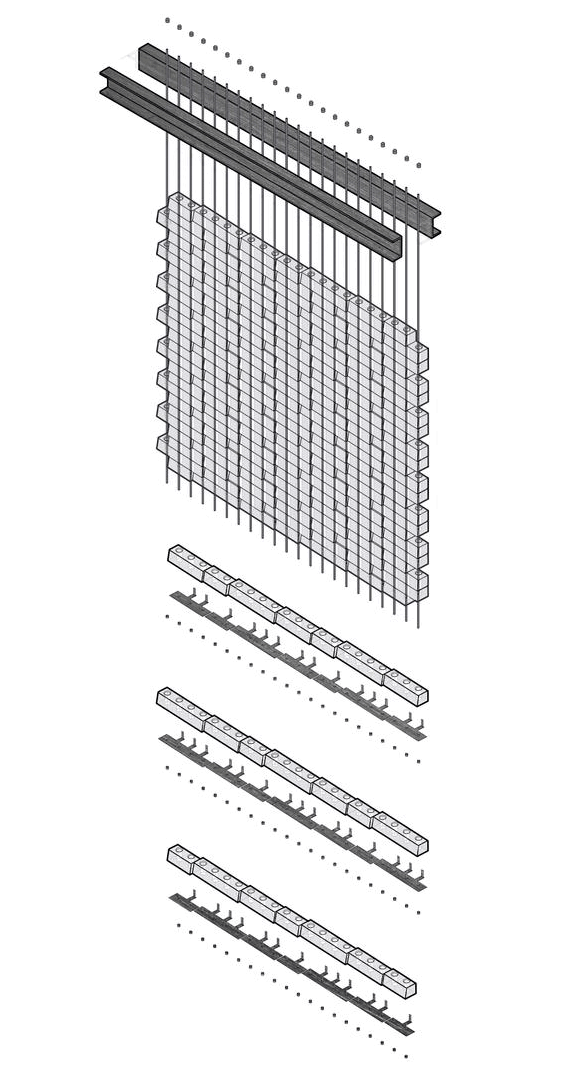ANIMATED MATERIALITY
Seoul Accelerator multimedia façade prototype
Georgia Institute of Technology | School of Architecture
Design Critic Marc Simmons, Thomas W. Ventulett III Distinguished Chair
Course Design + Research Studio | Spring 2017
Construction 2018
Location Atlanta, Georgia
Collaborators Chao Dang, Coston Dickinson, Matt Forsell, Paul Petromichelis, Nicole Schmeider, Vincent Yee
Fabricators + Consultants Steinert Industries, Janke Glass Studios, Metal Fabricators Inc., Dr. Mathew Swarts, Dr. Russell Gentry
In the Seoul Accelerator project, the design of the facade consisted in a tension-supported, custom, glass brick wall with a rusticated surface texture to allow in abundant natural light while providing complete privacy for the researchers and fabricators.
Each cast glass masonry is sleeved into stainless steel rods and clamped into place, the system does not need caulking or gaskets, as it is a thermal cavity barrier. Within the glass brick façade, an addressable low-resolution LED array is mounted across all surfaces of the building, allowing for a “Dusk ‘till Dawn” urban landscape and 24-7 operations.
The challenge within the Seoul Accelerator project was to build a full scale sized mock-up of this facade, we built a 7’ by 9’ portion of the facade with more than 200 casted glass bricks. The prototype has more than 1500 LED lights installed and its controlled with an arduino board programmed using C. Our prototype is located at the Hinman Research Building in Georgia Tech and it’s meant to be a dynamic state of the art installation, able to be changed with the pass of time, maintaining its validity in the future. The display loops through a established set of dynamic mods with a pixelated abstract theme, following what we designed for the building.
THE FABRICATION.
This innovative mold features a movable wall that can be positioned to create 20.32, 30.48, or 40.64 centimeter glass blocks. The mold's detachable design facilitates effortless glass removal and controlled cooling. The mold incorporates a heat-resistant handle due to the high temperatures involved. Weighing 54.5 kilograms, the mold features drafted edges to prevent glass adhesion. The movable wall's versatility poses timing challenges, as optimal glass block formation requires precise heating and cooling durations. To prevent thermal shock and ensure consistent light diffusion, the mold should be preheated before the initial glass pour. The resulting cooling marks on the glass enhance its light-scattering properties, allowing for optimal illumination with our LED lighting system.
The raw glass is melted to 1371.2 degrees Celsius within the glass oven. Subsequently, the molten glass is extracted using a ladle from a pool of the liquefied material. The higher the temperature of the glass, the more readily it levels out due to gravitational forces, facilitating a smooth pour from the ladle. The glass is poured quickly and precisely into the mold using a ladle then excess glass is removed with scissors to achieve the desired level. After pouring, the glass must cool and solidify within the mold to prevent slumping. Once cooled, the mold is carefully removed to release the glass brick.
The glass brick is briefly torched to maintain stability and prevent cracking during cooling. It is then annealed in a kiln for 24 hours to achieve optimal strength. The finished brick exhibits minor surface imperfections due to the cooling process. Its sloped face creates a shingle effect, while the staggered holes produce a spiral pattern when stacked in a staggered arrangement.
























